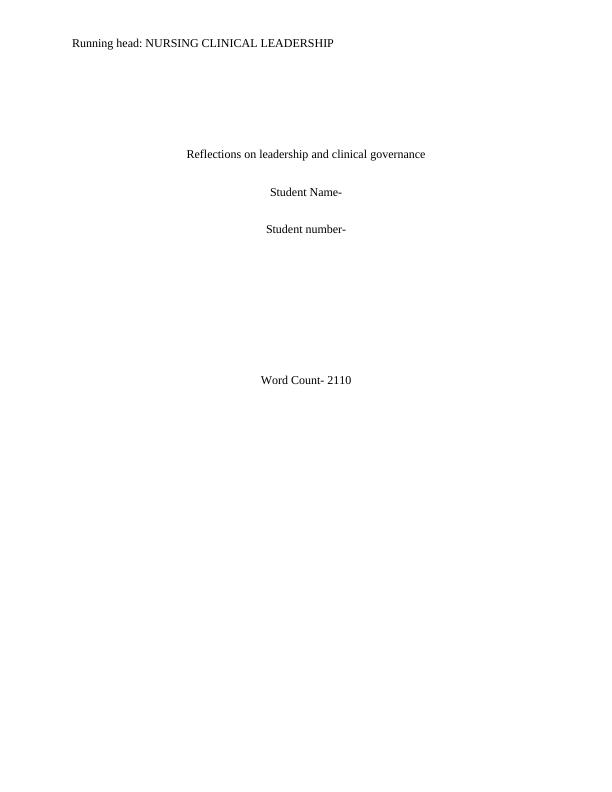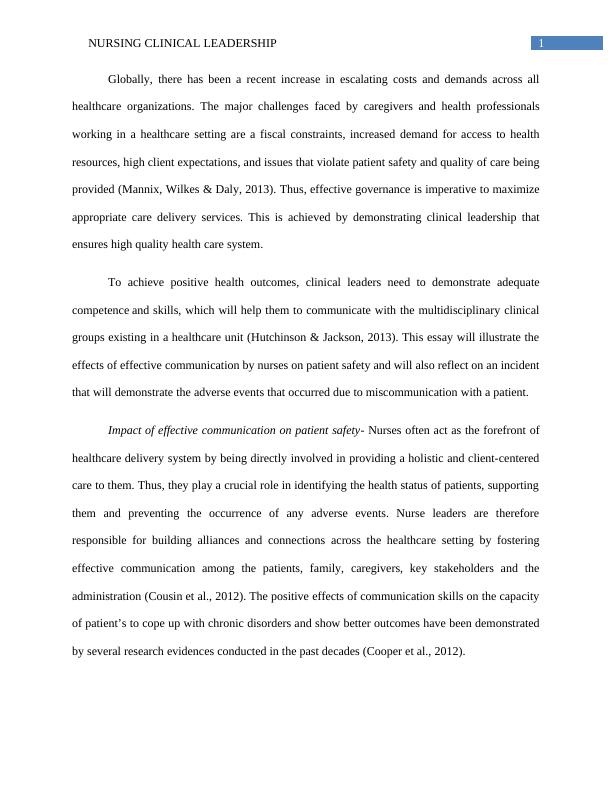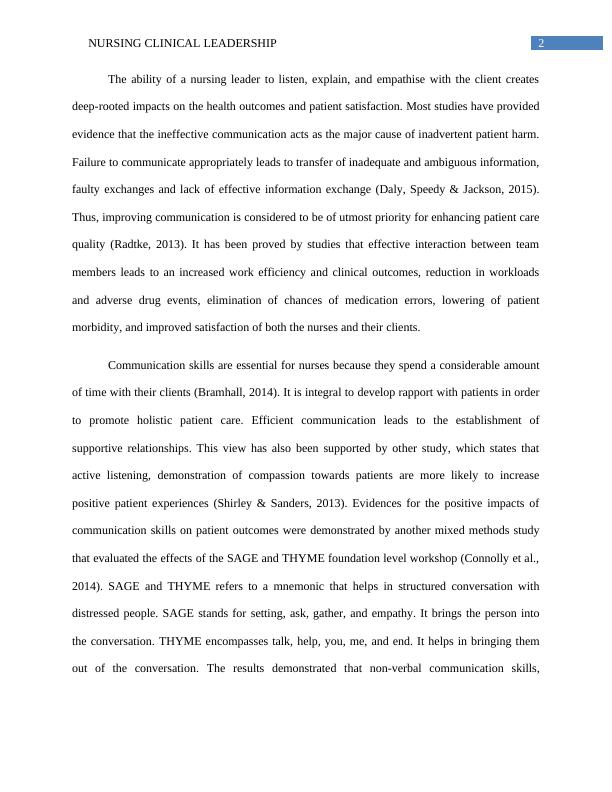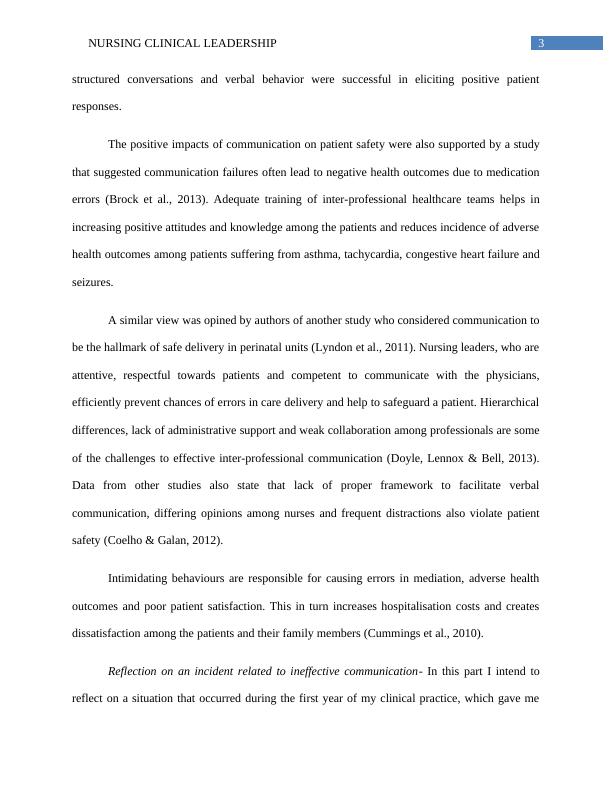HNN320 Leadership and Clinical Governance Assignment
13 Pages3463 Words296 Views
Leadership and Clinical Governance (HNN320)
Added on 2020-04-21
HNN320 Leadership and Clinical Governance Assignment
Leadership and Clinical Governance (HNN320)
Added on 2020-04-21
ShareRelated Documents
Running head: NURSING CLINICAL LEADERSHIPReflections on leadership and clinical governanceStudent Name-Student number-Word Count- 2110

1NURSING CLINICAL LEADERSHIPGlobally, there has been a recent increase in escalating costs and demands across allhealthcare organizations. The major challenges faced by caregivers and health professionalsworking in a healthcare setting are a fiscal constraints, increased demand for access to healthresources, high client expectations, and issues that violate patient safety and quality of care beingprovided (Mannix, Wilkes & Daly, 2013). Thus, effective governance is imperative to maximizeappropriate care delivery services. This is achieved by demonstrating clinical leadership thatensures high quality health care system. To achieve positive health outcomes, clinical leaders need to demonstrate adequatecompetenceand skills, which will help them to communicate with the multidisciplinary clinicalgroups existing in a healthcare unit (Hutchinson & Jackson, 2013). This essay will illustrate theeffects of effective communication by nurses on patient safety and will also reflect on an incidentthat will demonstrate the adverse events that occurred due to miscommunication with a patient. Impact of effective communication on patient safety- Nurses often act as the forefront ofhealthcare delivery system by being directly involved in providing a holistic and client-centeredcare to them. Thus, they play a crucial role in identifying the health status of patients, supportingthem and preventing the occurrence of any adverse events. Nurse leaders are thereforeresponsible for building alliances and connections across the healthcare setting by fosteringeffective communication among the patients, family, caregivers, key stakeholders and theadministration (Cousin et al., 2012). The positive effects of communication skills on the capacityof patient’s to cope up with chronic disorders and show better outcomes have been demonstratedby several research evidences conducted in the past decades (Cooper et al., 2012).

2NURSING CLINICAL LEADERSHIPThe ability of a nursing leader to listen, explain, and empathise with the client createsdeep-rooted impacts on the health outcomes and patient satisfaction. Most studies have providedevidence that the ineffective communication acts as the major cause of inadvertent patient harm.Failure to communicate appropriately leads to transfer of inadequate and ambiguous information,faulty exchanges and lack of effective information exchange (Daly, Speedy & Jackson, 2015).Thus, improving communication is considered to be of utmost priority for enhancing patient carequality (Radtke, 2013). It has been proved by studies that effective interaction between teammembers leads to an increased work efficiency and clinical outcomes, reduction in workloadsand adverse drug events, elimination of chances of medication errors, lowering of patientmorbidity, and improved satisfaction of both the nurses and their clients. Communication skills are essential for nurses because they spend a considerable amountof time with their clients (Bramhall, 2014). It is integral to develop rapport with patients in orderto promote holistic patient care. Efficient communication leads to the establishment ofsupportive relationships. This view has also been supported by other study, which states thatactive listening, demonstration of compassion towards patients are more likely to increasepositive patient experiences (Shirley & Sanders, 2013). Evidences for the positive impacts ofcommunication skills on patient outcomes were demonstrated by another mixed methods studythat evaluated the effects of the SAGE and THYME foundation level workshop (Connolly et al.,2014). SAGE and THYME refers to a mnemonic that helps in structured conversation withdistressed people. SAGE stands for setting, ask, gather, and empathy. It brings the person intothe conversation. THYME encompasses talk, help, you, me, and end. It helps in bringing themout of the conversation. The results demonstrated that non-verbal communication skills,

3NURSING CLINICAL LEADERSHIPstructured conversations and verbal behavior were successful in eliciting positive patientresponses. The positive impacts of communication on patient safety were also supported by a studythat suggested communication failures often lead to negative health outcomes due to medicationerrors (Brock et al., 2013). Adequate training of inter-professional healthcare teams helps inincreasing positive attitudes and knowledge among the patients and reduces incidence of adversehealth outcomes among patients suffering from asthma, tachycardia, congestive heart failure andseizures. A similar view was opined by authors of another study who considered communication tobe the hallmark of safe delivery in perinatal units (Lyndon et al., 2011). Nursing leaders, who areattentive, respectful towards patients and competent to communicate with the physicians,efficiently prevent chances of errors in care delivery and help to safeguard a patient. Hierarchicaldifferences, lack of administrative support and weak collaboration among professionals are someof the challenges to effective inter-professional communication (Doyle, Lennox & Bell, 2013).Data from other studies also state that lack of proper framework to facilitate verbalcommunication, differing opinions among nurses and frequent distractions also violate patientsafety (Coelho & Galan, 2012).Intimidating behaviours are responsible for causing errors in mediation, adverse healthoutcomes and poor patient satisfaction. This in turn increases hospitalisation costs and createsdissatisfaction among the patients and their family members (Cummings et al., 2010).Reflection on an incident related to ineffective communication- In this part I intend toreflect on a situation that occurred during the first year of my clinical practice, which gave me

End of preview
Want to access all the pages? Upload your documents or become a member.
Related Documents
Relationship between Leadership Styles and Patient Safetylg...
|6
|1662
|209
Clinical Leadership and Nursing: A Literature Reviewlg...
|8
|2043
|306
Clinical Leadership in Nursing PDFlg...
|10
|2459
|83
Comparison of Transformative and Autocratic Leadership Styles in Nursinglg...
|9
|2269
|61
Nursing Leadership: Importance, Theories, and Recommendationslg...
|8
|1757
|491
Management and Leadership of Professional Nursinglg...
|17
|5306
|27
